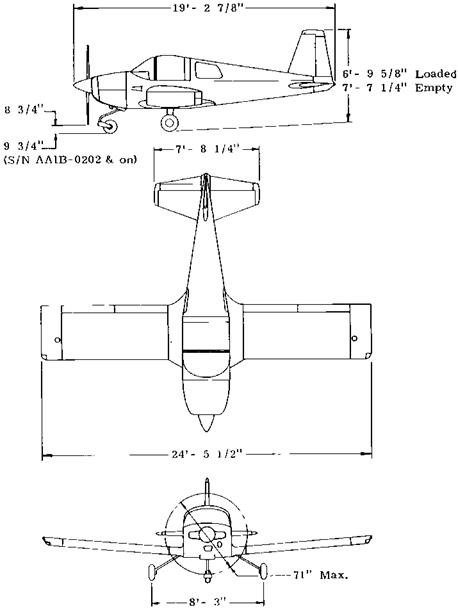The Case of the Grumman/American AA-1B
The Grumman/American AA-1B Yankee, its Tr-2 trainer version, and the Tiger four-seat variant are clever, innovative personal airplane designs. Compared with most airplanes of the type, which are built as riveted metal structures, metal-to-metal bonding on these airplanes eliminates drag due to rivets and skin waviness and the points of stress concentration common to riveted structures. More than 2,000 AA-1B’s have been built, under several designations. Yet the AA-1B has compiled a sad record of crashes as a result of unrecoverable spins. The AA-1B has a flat spin mode that leads to a high-impact vertical crash with the fuselage level, a crash that has made paraplegics out of student pilots and their instructors.
The airplane’s three-view diagram suggests that NACA spin recovery criteria were quite disregarded in the original design. The horizontal tail is mounted low on the fuselage, providing very little tail damping ratio, or TDR (Figure 9.7). By NACA correlation, this would promote a high angle of attack, or flat spin. Also, there appears to be virtually no unshielded rudder area, the NACA URVC factor.
The AA-1B’s poor spin and recovery characteristics are recognized in the 1975 version of the owner’s manual. In both the operating procedures and operating limitations sections
|
Figure 9.7 Grumman-American AA-1B, known for unrecoverable flat spins. There is very little fuselage side area under the horizontal tail, needed for spin damping according to the NASA TDR criterion. There is also little unshielded rudder area above the horizontal tail. (From AA-1B Owner’s Manual) |
the legend “SPINS ARE PROHIBITED” is displayed. This is followed by the recovery technique in the event of inadvertent spins, and the note:
If recovery controls are not briskly applied in the first turn, more than one additional turn will be required for recovery. For quick recovery, apply full anti-spin controls as the spin begins, before one turn is completed.
A later version of the owner’s manual has wording that reflects actual NASA flight-testing experience:
There is evidence that permitting the airplane to go beyond one turn without initiating proper recovery procedures can allow a spin mode to develop from which recovery is not possible.
To illustrate this point, the 1/15 December 1990 issue of Aviation Consumer reports that American Aviation test pilot Bob Hommel was forced to jump when a modified AA-1A failed to recover during a spin test. The airplane was said to have completed over 100 turns before crashing. There is no reason to think that the AA-1B airplane is unique in having recovery problems in spins that go beyond one turn. James S. Bowman, Jr., writes as follows:
I think it is important to mention that all normal category airplanes are tested for one-turn spins only and if taken beyond one turn, recovery may be slow, or there may be no recovery at all.












